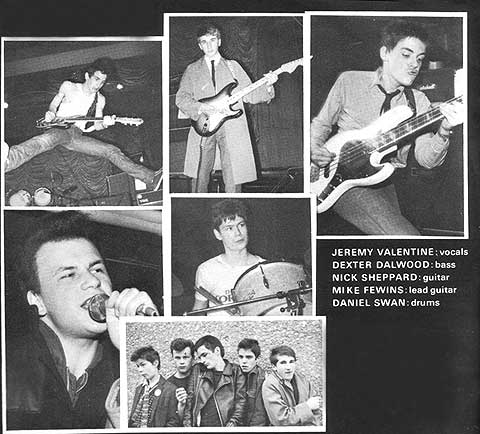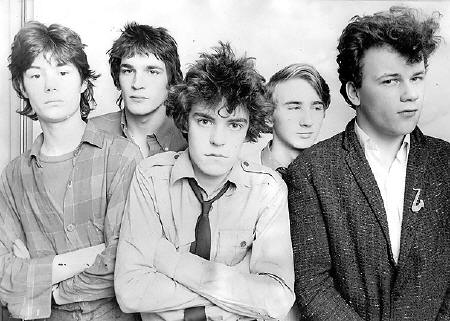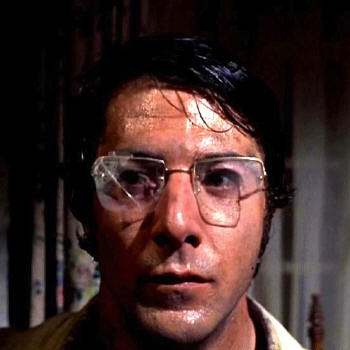|
|
| home | features | exhibitions | interviews | profiles | webprojects | gazetteer | links | archive | forum |
|
Dexter Dalwood on collage, punk, Straw Dogs and 1971 Dexter Dalwood's paintings are on show at Tate St Ives during Spring 2010. He has also co-curated a show of works from 1971 selected from the Tate collection. Interview Rupert White.
How do think of this show at Tate St Ives in relation to your career? Is it a retrospective? In a way. But I'm 49. I don't think you can have a retrospective till after sixty, so it's more a 'mid-career survey' really. If, say, in 10 years I was going to do a retrospective, I'd go with earlier as well as later paintings, with some works that don't necessarily fit in with what I'm doing now.
I was 37 then...not exactly young!
So you have quite a big back catalogue that many people haven't seen. But the work that's here has a consistency... I'd say this is when I emerged as an artist. Before I was trying things out. It takes a long time to find what you want to do - especially with painting.
The consistency: is that something to do with your working method? Has that been a constant during this period? Making a collage before the painting has remained but what's changed with the later work is that the collages are not so particular. I used to cut things out very carefully. Now I'm using one or two elements only and often the colour - like that blue in the 'Death of David Kelly' (picture above right) - isn't in the collage. Instead I'm thinking about an emotional thump that I want in the painting as flat colour.
So the more recent paintings are less planned beforehand? Yes, and the more recent works have a different idea of space physically. Rather than a space that you project into, it becomes more emotional somehow.
These recent works do appear flatter - less like 3D room interiors - they have a painterly space that reminds me of Francis Bacon... I'm interested in the way Bacon puts down one single colour: say an orange. And also the myth that he worked spontaneously. Actually they were very planned paintings. There's one dramatic piece of incident in each painting, but actually they're very delicate. There's a thin purple ground, then an orange line, and a bit of green, then suddenly, in the middle, there's a splodge of something. I've always been interested in Indian miniature painting and that idea of how you can use flat colour on a grander scale with figurative elements. He understood that you could have figurative elements across a ground and make an enclosed space that somehow works for the viewer.
With all those eg The Queens Bedroom (picture left) people used to give me old magazines like Elle Decoration. Someone gave me a set of Interiors dating from 1979: I had a stack of them. I used to go through them looking for stuff. I didn't used to scale them, so I had to find images the right size. I used to keep them in little drawer cabinets: mirrors, chandeliers, curtains each with their own drawer. Then I'd have an idea for a room of some sort. I'd do a small pencil drawing, then I'd start the collage. Later on I started using reproductions of other artists. So in the Ceaucescu painting (picture below right) the chandelier is on top of a very small detail from a Baselitz painting. I'm looking for what I feel is n't the most obvious reference. I'm interested in it somehow gelling so it becomes more than its elements.
Your paintings are often referred to as history paintings because they refer to historical events, yet the way they depict the event is almost completely fictional and subjective. But they're truthful at other levels - so as you say you'll use furniture, or an artist who was contemporaneous with the event, for example. I'm interested in the slippage between the idea of what things looks like and what you imagine they look like. It's like the difference between reading a novel and seeing the film adaptation. Your imagination is often better than the realised adaptation, so you then think 'I would n't have thought it was like this'. All histories are made up and fictional anyway. There is no real real history. It's all a construct of some sort. So it seems that painting could be allowed to somehow explore some of that ambiguity.
When I was doing my post graduate degree 1988-1990 he was at his absolute peak. Everyone in art school then was painting a photograph and dragging a big brush across it. It was the 'Richteresque'. People would say 'what is it on the Richter scale'?. Critics would like Richter but not painting, because painting behaved so badly in the 80's and everyone became so embarrassed about it. There was a reaction against this. I was thinking 'why isn't it possible not to make images of all the things you're interested in a way that you're not constrained by style?'. I thought I could bring in all the stuff I was interested but I could do it in a way that would make an interesting painting now.
Is it significant that the first painting in this show was made in 1997: the same year of the 'Sensation' show? What do you make of what happened with British art in the 90s? If you went to Cork St in 1983 there might have been an international artist, may be at Waddington's, may be Eric Fischl might have had a show there, but really there was so little to see. There were no American artists who wanted to show in London. Everybody wanted to show in Germany. So what happened in the 90s was extraordinary. This complete flip round. London, and with Tate Modern opening, became this unbelievable international centre where every artist in the world wanted to show their work.
Was the time right for a certain type of painting then? Thinking of eg Gary Hume, painting was all pretty hard. In a way I don't think there was much image making that was about the imagination. Although, saying that, I don't like painting that is just about the imagination. I wanted it to be tough, but to include that possibility.
Let's talk about 1971. Why did you choose that date for the show you have curated downstairs at Tate St Ives? You were living in Cornwall then, in Penzance which is not far from St Ives, but were there other factors?
I think that point between '70 and '75 is a very interesting period of time. Historically it's got slightly swept away. The sixties are very clear: Pop Art; '68. And then punk's very clear in British culture and what happened as a consequence of that, but then there's that odd period between '69 and '72 which musically was a fantastic period of time. Also the counter culture: the hippy, soft side of it hardened up particularly after the Kent State incident. Everything that was soft and easy-going became very tough. And there were the Vietnam War demonstrations. Thinking of the films coming out then: Polanski's Macbeth, Straw Dogs, Clockwork Orange: there was an obsession with violence and how, as an artist, to deal with violence. It was an interesting period to think about and to do a cross-generational thing with. Someone like Kokoschka was painting then (picture above right), yet Dan Graham was making his conceptual art at the same time.
There were signs of the end of modernism and the beginning of postmodernism...there was a paradigm shift happening. Yes absolutely. And a lot of the French theory - poststructuralism - was coming out then.
You mentioned 'Straw Dogs' which was filmed near St Ives, and an incident at your school in Penzance when one of your schoolmates brought in a decommissioned Colt '45 that had been used in the film. Presumably you didn't see the film until somewhat later but you'll have remembered the way the local community - some who were extras in the film - responded. It was all very exciting. My Dad had a bookshop in Penzance and Peckinpah came in. Although he was a mad, drunken, wild guy he was also very literary. I was talking to Alan Cristea who ran a gallery and used to work at Waddington's and he said that Peckinpah came in with Jason Coburn both bombed out of their heads in 1973 and he asked 'Have you got any paintings by that crazy fucking Cornish artist, that Roger Hilton'? 'Any of those fucking chickens?' And he bought five paintings. And so when he was here in Cornwall he obviously clocked what was going on. Peckinpah lived here for a year and a half. The collector's edition DVD has a local TSW black and white film interviewing Dustin Hoffman.
He was massive. The story behind it is that he tried to get Peckinpah sacked. He thought it was going the wrong way. When they first came here he went into the sea at Land's End and got pneumonia and shooting stopped for 3 weeks.
The film is controversial for a number of reasons - not least its depiction of the Cornish which is very caricatured and less than flattering... I watched it again about 3 weeks ago. It's an incredible psychological film about relationships. He's bored of her and she's bored of him and they behave like kids, in a way, in their relationship. She's back home and compromised by this, and there's the whole thing about him finding the violence within him when he finally snaps at the end.
A number of the St Ives artists were living less than a mile from the main location of Straw Dogs. Its interesting to think about how their painting relates to these aspects of mainstream 70's culture...there's a striking distance between them... The vague subtext of the '71 show is that what was going on with the artists in Cornwall is that they were still chasing modernist form. Given this movement towards Land Art in Upper State New York, Robert Smithson and Robert Morris and Christo in Europe, its surprising that none of them in St Ives were thinking about doing something physically with the landscape. They were still locked into a modernist mindset.
I like Peter Lanyon but not en masse. The sculpture that was in the Dark Monarch show - the glass - could have been made last week. Really contemporary. But some of the bluster of abstract expressionism feels a bit limp now. Bryan Wynter's work: I do like the eccentric hippiness of it. The IMOOS (detail picture right) are quite extraordinary.
You said earlier that you visited him at his house when you were a kid with your uncle Hubert Dalwood. He used to have copper pans and palettes hanging up. A curator now would say 'this should be the work. This would be a fantastic installation'. And mirrors. Simply looking at the possibility of reflections and colour. The amazing thing about those artists was that they weren't showing a lot commercially. They were just doing it for the sake of doing it...
Then you moved to Bristol and later became
bass player with 'The Cortinas'. What did you learn from being in a pretty
successful band at such a young age? How has that experience affected the rest
of your career?
 Becoming
a professional musician at 17 was incredibly exciting . But in becoming a job
and the pressure of the music business at that age was difficult to handle.
You don't appreciate that having a break like that is rare until after the
event. Also having some success at something and then realizing its not really
what I wanted to do meant that by the time I got to Art School I knew the
value of it. Becoming
a professional musician at 17 was incredibly exciting . But in becoming a job
and the pressure of the music business at that age was difficult to handle.
You don't appreciate that having a break like that is rare until after the
event. Also having some success at something and then realizing its not really
what I wanted to do meant that by the time I got to Art School I knew the
value of it.Would you agree that artists are being 'picked up' at a younger and younger age - many fresh out of college? I often hear people often say that this means they lack life experience and this is reflected in their art. Whats your view on this?
It is hard to
withstand expectations if you have just left college and everyone wants your
work its hard to allow yourself to develop. But I do think you can make
interesting art at any age. Michelangelo carved David at 29. Being an
artist and sustaining the activity through thick and thin is totally
different. Would Vincent Van Gogh really have continued without the support of
Theo? I don't think so. I didn't get a genuine break until I was 37 although I
had been painting since I was 21. But there is no formula.
|
|
|

 The
earliest painting here is 1997...
The
earliest painting here is 1997... 
 It's interesting to think that there were
other artists making history paintings in the early 90s. I've heard you talk before
about Gerhard Richter as someone who was hard to avoid at the time. Your
work is more subjective and playful though...
It's interesting to think that there were
other artists making history paintings in the early 90s. I've heard you talk before
about Gerhard Richter as someone who was hard to avoid at the time. Your
work is more subjective and playful though...
 I was born in 1960. I was ten in 1971. I saw the
early period of Roxy Music and David Bowie and was very involved in punk
(picture above with 'The Cortinas').
I was born in 1960. I was ten in 1971. I saw the
early period of Roxy Music and David Bowie and was very involved in punk
(picture above with 'The Cortinas'). 